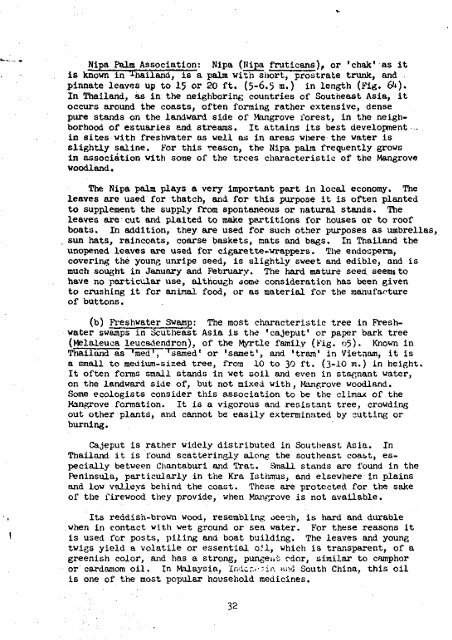Vegetation of Southeast Asia Studies of Forest Types 1963-1965
Vegetation of Southeast Asia Studies of Forest Types 1963-1965
Vegetation of Southeast Asia Studies of Forest Types 1963-1965
You also want an ePaper? Increase the reach of your titles
YUMPU automatically turns print PDFs into web optimized ePapers that Google loves.
Nipa Pain Association: Nipa (Hipa fruticons), or 'chak' as it<br />
is known in Thailand, is a palm with short, prostrate trunk, and<br />
pinnate leaves up to 15 or 20 ft. (5-6.5 ra.) in length (Fig. &0.<br />
In Thailand, as in the neighboring countries <strong>of</strong> <strong>Southeast</strong> <strong>Asia</strong>, it<br />
occurs around the coasts, <strong>of</strong>ten forming rather extensive, dense<br />
pure stands on the landward side <strong>of</strong> Mangrove forest, in the neighborhood<br />
<strong>of</strong> estuaries end streams. It attains its best development<br />
in sites with freshwater as well as in areas where the water is<br />
slightly saline. For this reason, the Nipa palm frequently grows<br />
in association with some <strong>of</strong> the trees characteristic <strong>of</strong> the Mangrove<br />
woodland.<br />
The Nipa palm plays a very important part in local economy. The<br />
leaves are used for thatch, and for this purpose it is <strong>of</strong>ten planted<br />
to supplement the supply from spontaneous or natural stands. The<br />
leaves are cut and plaited to make partitions for houses or to ro<strong>of</strong><br />
boats. In addition, they are used for such other purposes as umbrellas,<br />
sun hats, raincoats, coarse baskets, mats and bags. In Thailand the<br />
unopened leaves are used for cigarette-wrappers. The endosperm,<br />
covering the young unripe seed, is slightly sweet and edible, and is<br />
much sought in January and February. The hard mature seed seemjto<br />
have no particular use, although dome consideration has been given<br />
to crushing it for animal food, or as material for the manufacture<br />
<strong>of</strong> buttons.<br />
(b) Freshwater Swamp; The most characteristic tree in Freshwater<br />
swamps in <strong>Southeast</strong> <strong>Asia</strong> is the 'cajeput 1 or paper bark tree<br />
(Melaleuca leucadendron), <strong>of</strong> the Myrtle family (Fig. 65). Known in<br />
Thailand as ''hied 1 , 'samed 1 or 'samet 1 , and 'tram' in Vietnam, it is<br />
a small to medium-sized tree, from 10 to 30 ft. (3-10 m.) in height.<br />
It <strong>of</strong>ten forms small stands in wet soil and even in stagnant water,<br />
on the landward side <strong>of</strong>, but not mixed with, Mangrove woodland.<br />
Some ecologists consider this association to be the climax <strong>of</strong> the<br />
Mangrove formation. It is a vigorous and resistant tree, crowding<br />
out other plants, and cannot be easily exterminated by cutting or<br />
burning.<br />
Cajeput is rather widely distributed in <strong>Southeast</strong> <strong>Asia</strong>. In<br />
Thailand it is found scatteringly along the southeast coast, especially<br />
between Chontaburi and Trat. Small stands are found in the<br />
Peninsula, particularly in the Kra Isthmus, and elsewhere in plains<br />
and low valleys behind the coast. These are protected for the sake<br />
<strong>of</strong> the firewood they provide, when Mangrove is not available.<br />
Its reddish-brown wood, resembling oeech, is hard and durable<br />
when in contact with wet ground or sea water. For these reasons it<br />
is used for posts, piling and boat building. The leaves and young<br />
twigs yield a volatile or essential o:.I, which is transparent, <strong>of</strong> a<br />
greenish color, and has a strong, pungent- rdor, similar to camphor<br />
or cardamom oil. In Malaysia, Indc.vr-if 1 . H;KJ South China, this oil<br />
is one <strong>of</strong> the most popular household medicines.<br />
; 32
















